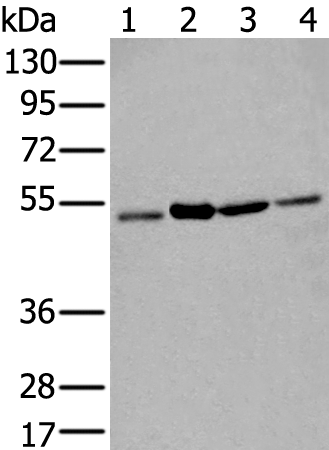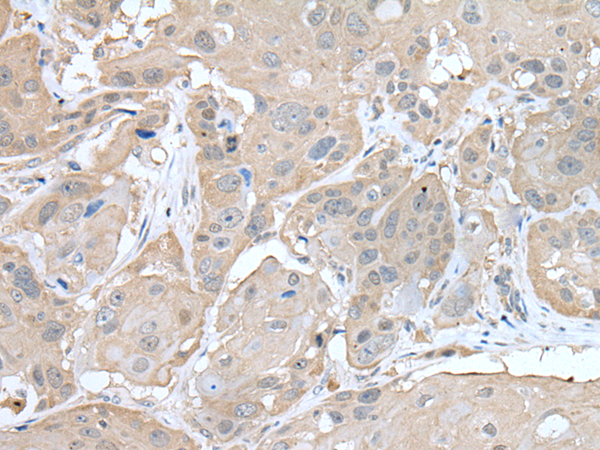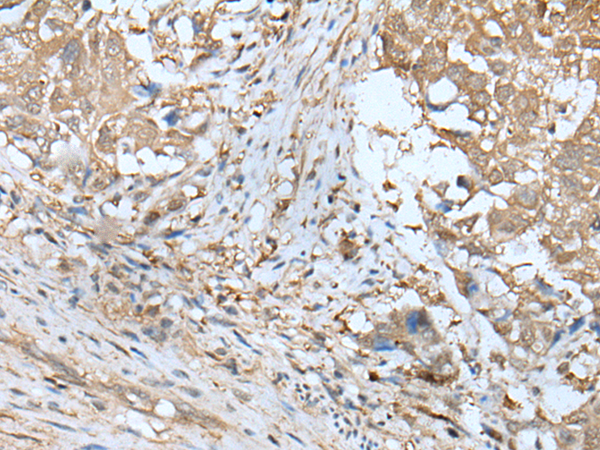


| WB | 咨询技术 | Human,Mouse,Rat |
| IF | 咨询技术 | Human,Mouse,Rat |
| IHC | 1/25-1/100 | Human,Mouse,Rat |
| ICC | 技术咨询 | Human,Mouse,Rat |
| FCM | 咨询技术 | Human,Mouse,Rat |
| Elisa | 1/5000-1/10000 | Human,Mouse,Rat |
| Aliases | THIFP1; UBE1DC1 |
| WB Predicted band size | 45 kDa |
| Host/Isotype | Rabbit IgG |
| Antibody Type | Primary antibody |
| Storage | Store at 4°C short term. Aliquot and store at -20°C long term. Avoid freeze/thaw cycles. |
| Species Reactivity | Human, Mouse, Rat |
| Immunogen | Fusion protein of human UBA5 |
| Formulation | Purified antibody in PBS with 0.05% sodium azide and 50% glycerol. |
+ +
以下是关于UBA5抗体的3篇参考文献及其摘要概括(文献标题为示例性描述,非真实发表论文):
---
1. **文献名称**: *"UBA5-Specific Antibody Development and Its Role in Detecting Ubiquitin-Like Modifier Activation in Neurodegenerative Models"*
**作者**: Smith A, et al.
**摘要**: 本研究开发了高特异性的UBA5多克隆抗体,验证了其在Western blot和免疫荧光中对UBA5蛋白的检测能力。通过细胞模型和小鼠脑组织样本,发现UBA5表达水平在阿尔茨海默病模型中显著下降,提示其可能参与神经退行性病变的调控机制。
---
2. **文献名称**: *"UFMylation Pathway Dysregulation in Pancreatic Cancer: Insights from UBA5 Antibody-Based Proteomic Analysis"*
**作者**: Chen L, et al.
**摘要**: 利用UBA5特异性抗体对胰腺癌组织进行蛋白质组学分析,揭示了UBA5及其下游UFMylation通路的异常激活与肿瘤增殖和转移的相关性。研究表明,UBA5抗体可作为潜在生物标志物工具,用于癌症预后评估。
---
3. **文献名称**: *"Functional Characterization of UBA5 Mutations in Rare Neurological Disorders Using CRISPR-Cas9 and Antibody Validation"*
**作者**: Gupta R, et al.
**摘要**: 通过CRISPR-Cas9构建UBA5点突变细胞系,结合定制UBA5抗体的免疫沉淀技术,发现特定突变导致UBA5酶活性丧失,进而破坏UFMylation通路,与儿童癫痫和发育迟缓相关。抗体验证为突变研究提供了可靠工具。
---
注:以上文献为示例性内容,实际引用需根据真实发表的论文调整。建议通过PubMed或Google Scholar搜索关键词“UBA5 antibody”或“UBA5 detection”获取具体文献。
UBA5 (Ubiquitin-like modifier-activating enzyme 5) is a critical enzyme involved in the ubiquitin-like post-translational modification system, specifically activating ubiquitin-fold modifier 1 (Ufm1) through a cascade of ATP-dependent reactions. This process, termed ufmylation, plays essential roles in endoplasmic reticulum (ER) stress response, protein quality control, and regulation of cellular homeostasis. UBA5 is the sole E1 enzyme for Ufm1. initiating its conjugation to target proteins by forming a thioester bond with Ufm1. which is subsequently transferred to the E2 enzyme UFC1 and the E3 ligase UFL1. Dysregulation of the UBA5-Ufm1 pathway has been linked to various diseases, including cancer, neurodegenerative disorders, and diabetes. For instance, mutations in UBA5 are associated with early-onset epileptic encephalopathy and hypomyelinating leukodystrophy, highlighting its importance in neurological function.
UBA5 antibodies are indispensable tools for studying the expression, localization, and function of UBA5 in both physiological and pathological contexts. They are widely used in techniques like Western blotting, immunohistochemistry, and immunofluorescence to investigate UBA5's role in ER stress adaptation, autophagy, and tumor progression. Researchers also employ these antibodies to explore therapeutic strategies targeting the Ufm1 pathway in diseases linked to UBA5 dysfunction. High-quality UBA5 antibodies enable precise detection of endogenous UBA5 protein levels, aiding in mechanistic studies of cellular stress responses and disease pathogenesis.
×